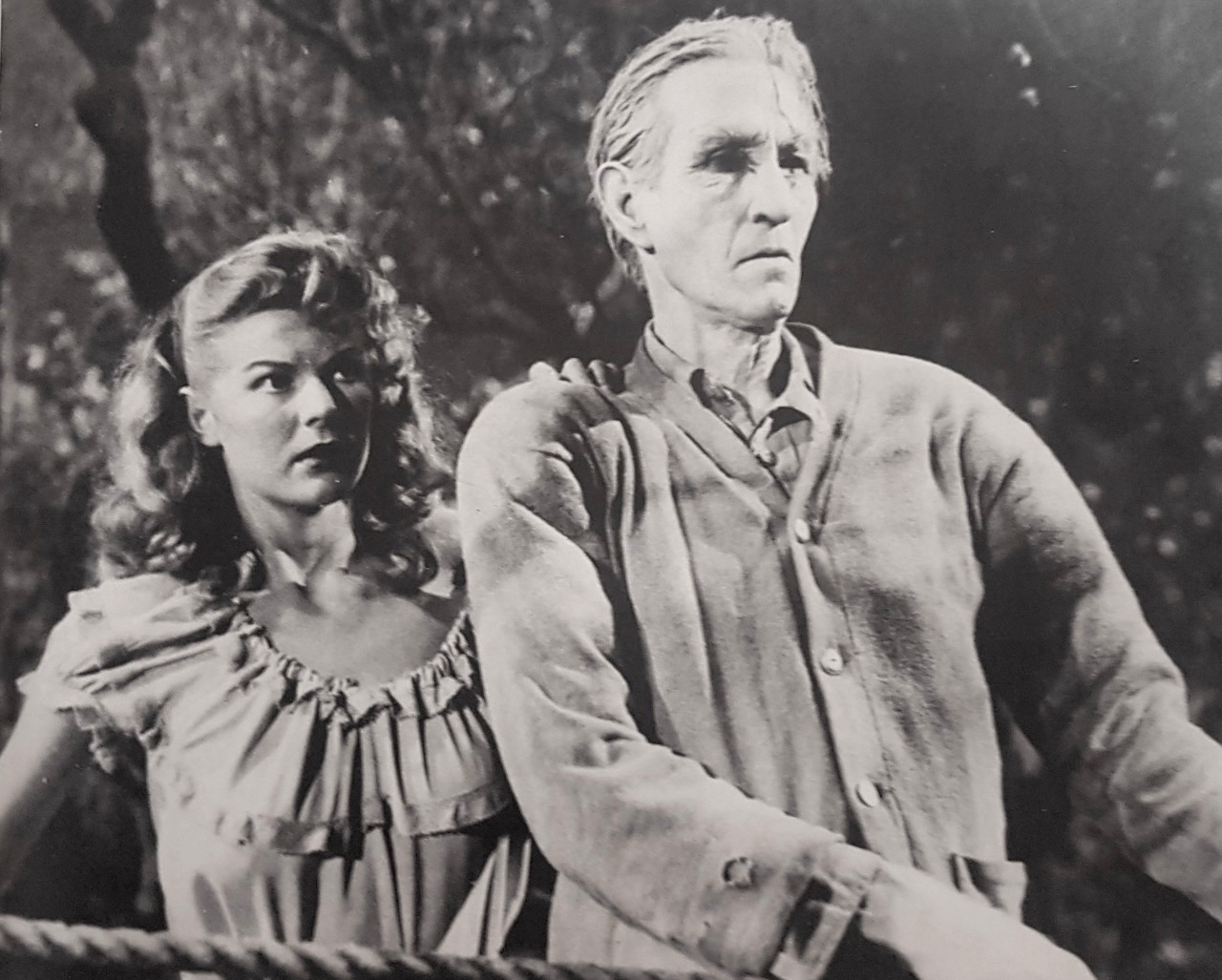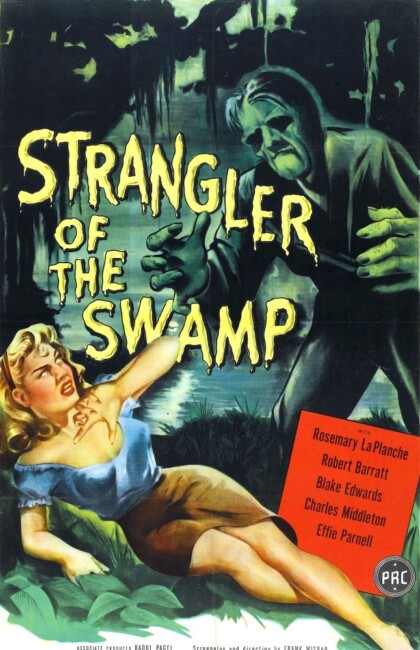Crew
Director/Screenplay – Frank Wisbar, Story – Leo McCarthy & Frank Wisbar, Additional Dialogue – Harold Erickson, Photography (b&w) – James S. Brown, Jr., Musical Director – Alexander Steinert, Makeup – Bud Westmore, Art Direction – Edward C. Jewell. Production Company – PRC Pictures.
Cast
Rosemary La Planche (Maria Hart), Blake Edwards (Christian ‘Chris’ Sanders Jr), Robert Barratt (Christian Sanders), Effie Parnell (Martina Sanders), Nolan Leary (Pete Jeffers), Charles Middleton (Ferryman Douglas), Frank Conlan (Joseph Hart)
Plot
A tiny village in the swamps is connected through the waters by a rope-drawn ferry. The villagers believe that people are being killed off by The Strangler, the vengeful spirit of the ferryman Douglas who was hung for a crime but died swearing that he was innocent. The current ferryman Joseph Hart is now killed by The Strangler. His granddaughter Maria arrives in the area and decides that she will take over the job of ferryman. During the course of this, she and Chris Sanders, son of the village’s most influential man, become attracted. However, the spirit of Ferryman Douglas then arrives to claim Chris.
Frank Wisbar (1899-1967), born Franz Wysbar, was a German director who emigrated to the USA. Wisbar made nine films in Germany during the 1930s but fled the county after being censored by the Nazis. He relocated in Hollywood where he turned out a number of low-budget films at the poverty row studios beginning with Secrets of a Sorority Girl (1945), as well as one other genre film The Devil Bat’s Daughter (1946). After failing to find much satisfaction in the US, Wisbar returned to post-War Germany in the 1950s and worked there up until his death.
Strangler of the Swamp is the best remembered film in Frank Wisbar’s largely forgettable oeuvre. It is a remake of Ferryman Maria (1936), which Wisbar had written and directed in Germany starring Sybille Schmitz as Maria. Strangler of the Swamp has gained a modest cult reputation – in part because of its being championed by William K. Everson in his book Classics of the Horror Film (1974).
The film is not widely recognised but is one of the few from PRC (Producers Releasing Corporation) to gain critical recognition – a studio that was otherwise notorious for their extreme penny-pinching productions. During this period, they had a healthy output of B Westerns, East Side Kids comedies and B mad scientist films such as The Devil Bat (1940), Dead Men Walk (1943) and The Monster Maker (1944).
On the other hand, his sterling authorship notwithstanding, I have certain difficulties with some of Everson’s choices. He seems biased towards the 1930s and 40s and almost entirely slights any of the films from Hammer or coming out during the 1960s and 70s. Many of the classics he covers stand up well today; others don’t seem deservous of their status. My feeling is that Strangler of the Swamp ranks as an interesting curiosity but today seems on the slow and creaky side.

The film suffers all the problems and corner-cutting stylistic effects associated with PRC’s films – the flat visual style (the result of quick turnaround shooting schedules and lack of time for multiple takes); the static camera set-ups; the typical B movie melodrama and romance plot; obvious sets; and little known actors. Before getting to the merits of the film, it should be noted that these are the characteristics that comprise the majority of it.
That said, the cheapness of the sets in this case actually benefit the film in that all of the swamp locations have been built on a stage (which seems to consist of an island that never appears to have more than three buildings and where the rope-drawn boat has to travel only a few dozen metres) while fog is used to cover any of the shortcomings. This gives the film the impression of taking place in a strange twilight netherworld all of its own.
Within all of this, Frank Wisbar creates some occasional moments of atmosphere, although nothing as truly haunted as anything that appears in say the films of Val Lewton being made around the same time – Cat People (1942), I Walked with a Zombie (1943) et al. The appearances of Charles Middleton’s ferryman is something spooky – it is worth remembering that this came at a time when the ghost story had failed to take a substantial foothold in US cinema and so must have had doubly more effect. (The vision of the ghost with the blacked out eyes must almost certainly have influenced Herk Harvey when it came to the making of Carnival of Souls (1962) sixteen years later).
All of that said, the story surrounding the ferryman’s appearances is a tried and true one of supernatural retribution, while the theme of the innocent offering her life in the place of her love is a treacly one that turned up in films of the German Expressionist movement. (Descriptions of the German film talk about Maria having to fight Death for her lover’s life – it is hard to tell if this is an idea that has been watered down here or just a mistranslation where the Death figure becomes no more than that of a ghost revenant).
One interesting trivia curiosity about Strangler of the Swamp is that the young love interest that Rosemary La Planche offers to trade her life for is played by none other than Blake Edwards. Edwards started out in the industry as an actor before branching out as a screenwriter and then in the 1950s as a director. As director, Edwards had a great deal of success principally with his comedies. He is best remembered for his collaborations with Peter Sellers, in particular the long-running series of Pink Panther films beginning with The Pink Panther (1963) and other works including the likes of Breakfast at Tiffany’s (1962), The Great Race (1965), 10 (1979) and Victor/Victoria (1982). He directed two films that can be considered genre material, The Pink Panther Strikes Again (1976), the fourth film in the series, and the bodyswap comedy Switch (1991).
Full film available here

